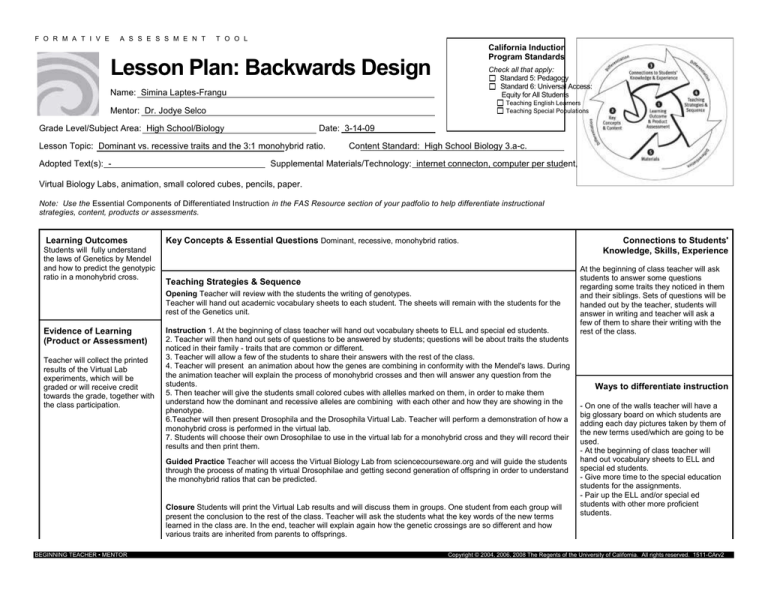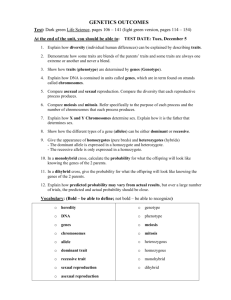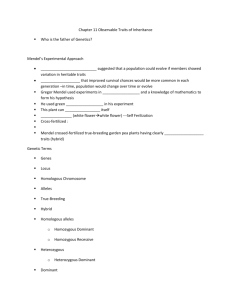
F O R M A T I V E
A S S E S S M E N T
T O O L
California Induction
Program Standards
Lesson Plan: Backwards Design
Check all that apply:
Standard 5: Pedagogy
Standard 6: Universal Access:
Equity for All Students
Name: Simina Laptes-Frangu
Teaching English Learners
Teaching Special Populations
Mentor: Dr. Jodye Selco
Grade Level/Subject Area: High School/Biology
Date: 3-14-09
Lesson Topic: Dominant vs. recessive traits and the 3:1 monohybrid ratio.
Adopted Text(s): -
Content Standard: High School Biology 3.a-c.
Supplemental Materials/Technology: internet connecton, computer per student,
Virtual Biology Labs, animation, small colored cubes, pencils, paper.
Note: Use the Essential Components of Differentiated Instruction in the FAS Resource section of your padfolio to help differentiate instructional
strategies, content, products or assessments.
Learning Outcomes
Students will fully understand
the laws of Genetics by Mendel
and how to predict the genotypic
ratio in a monohybrid cross.
Key Concepts & Essential Questions Dominant, recessive, monohybrid ratios.
Teaching Strategies & Sequence
Opening Teacher will review with the students the writing of genotypes.
Teacher will hand out academic vocabulary sheets to each student. The sheets will remain with the students for the
rest of the Genetics unit.
Evidence of Learning
(Product or Assessment)
Teacher will collect the printed
results of the Virtual Lab
experiments, which will be
graded or will receive credit
towards the grade, together with
the class participation.
Instruction 1. At the beginning of class teacher will hand out vocabulary sheets to ELL and special ed students.
2. Teacher will then hand out sets of questions to be answered by students; questions will be about traits the students
noticed in their family - traits that are common or different.
3. Teacher will allow a few of the students to share their answers with the rest of the class.
4. Teacher will present an animation about how the genes are combining in conformity with the Mendel's laws. During
the animation teacher will explain the process of monohybrid crosses and then will answer any question from the
students.
5. Then teacher will give the students small colored cubes with allelles marked on them, in order to make them
understand how the dominant and recessive alleles are combining with each other and how they are showing in the
phenotype.
6.Teacher will then present Drosophila and the Drosophila Virtual Lab. Teacher will perform a demonstration of how a
monohybrid cross is performed in the virtual lab.
7. Students will choose their own Drosophilae to use in the virtual lab for a monohybrid cross and they will record their
results and then print them.
Guided Practice Teacher will access the Virtual Biology Lab from sciencecourseware.org and will guide the students
through the process of mating th virtual Drosophilae and getting second generation of offspring in order to understand
the monohybrid ratios that can be predicted.
Closure Students will print the Virtual Lab results and will discuss them in groups. One student from each group will
present the conclusion to the rest of the class. Teacher will ask the students what the key words of the new terms
learned in the class are. In the end, teacher will explain again how the genetic crossings are so different and how
various traits are inherited from parents to offsprings.
BEGINNING TEACHER • MENTOR
Connections to Students'
Knowledge, Skills, Experience
At the beginning of class teacher will ask
students to answer some questions
regarding some traits they noticed in them
and their siblings. Sets of questions will be
handed out by the teacher, students will
answer in writing and teacher will ask a
few of them to share their writing with the
rest of the class.
Ways to differentiate instruction
- On one of the walls teacher will have a
big glossary board on which students are
adding each day pictures taken by them of
the new terms used/which are going to be
used.
- At the beginning of class teacher will
hand out vocabulary sheets to ELL and
special ed students.
- Give more time to the special education
students for the assignments.
- Pair up the ELL and/or special ed
students with other more proficient
students.
Copyright © 2004, 2006, 2008 The Regents of the University of California. All rights reserved. 1511-CArv2
F O R M A T I V E
A S S E S S M E N T
T O O L
Extension Activities or Independent Practice Students will have to use the Virtual Lab again to get a monohybrid
cross, extended to a dihybrid cross, then they will have to figure out what the ratios are, using the Virtual Lab
Computer for showing the ratios. In the end, they will have to present their findings as an essay which will be
submitted to the teacher next class and will be graded.
Materials Internet connection, computers for each student, Virtual Biology Lab access, small colored cubes, pencils, paper.
Adapted from the work of Wiggins and McTigue.
BEGINNING TEACHER • MENTOR
Copyright © 2004, 2006, 2008 The Regents of the University of California. All rights reserved. 1511-CArv2







